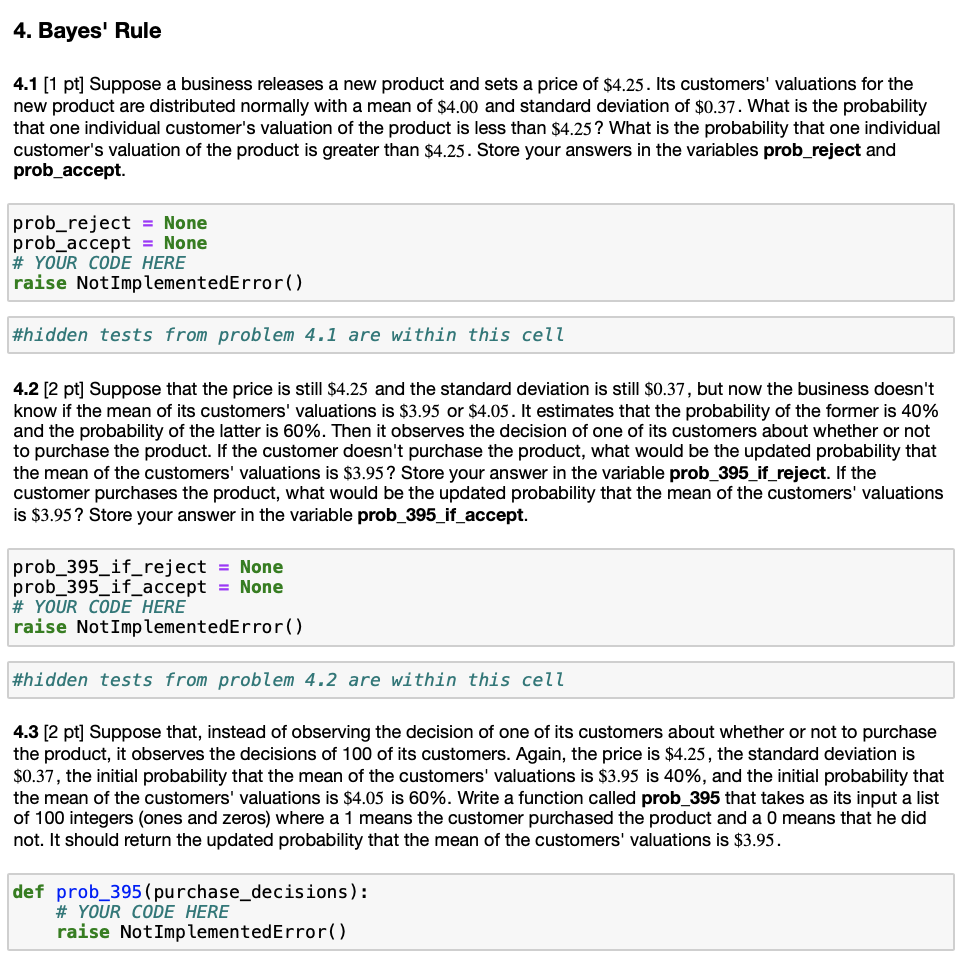Answered step by step
Verified Expert Solution
Question
1 Approved Answer
4. Bayes' Rule 4.1 [1 pt] Suppose a business releases a new product and sets a price of $4.25. Its customers' valuations for the

4. Bayes' Rule 4.1 [1 pt] Suppose a business releases a new product and sets a price of $4.25. Its customers' valuations for the new product are distributed normally with a mean of $4.00 and standard deviation of $0.37. What is the probability that one individual customer's valuation of the product is less than $4.25? What is the probability that one individual customer's valuation of the product is greater than $4.25. Store your answers in the variables prob_reject and prob_accept. prob_reject = None prob_accept = None # YOUR CODE HERE raise NotImplementedError() #hidden tests from problem 4.1 are within this cell 4.2 [2 pt] Suppose that the price is still $4.25 and the standard deviation is still $0.37, but now the business doesn't know if the mean of its customers' valuations is $3.95 or $4.05. It estimates that the probability of the former is 40% and the probability of the latter is 60%. Then it observes the decision of one of its customers about whether or not to purchase the product. If the customer doesn't purchase the product, what would be the updated probability that the mean of the customers' valuations is $3.95? Store your answer in the variable prob_395_if_reject. If the customer purchases the product, what would be the updated probability that the mean of the customers' valuations is $3.95? Store your answer in the variable prob_395_if_accept. prob_395_if_reject = None prob_395_if_accept = None # YOUR CODE HERE raise NotImplementedError() #hidden tests from problem 4.2 are within this cell 4.3 [2 pt] Suppose that, instead of observing the decision of one of its customers about whether or not to purchase the product, it observes the decisions of 100 of its customers. Again, the price is $4.25, the standard deviation is $0.37, the initial probability that the mean of the customers' valuations is $3.95 is 40%, and the initial probability that the mean of the customers' valuations is $4.05 is 60%. Write a function called prob_395 that takes as its input a list of 100 integers (ones and zeros) where a 1 means the customer purchased the product and a 0 means that he did not. It should return the updated probability that the mean of the customers' valuations is $3.95. def prob_395 (purchase_decisions): # YOUR CODE HERE raise NotImplementedError()
Step by Step Solution
There are 3 Steps involved in it
Step: 1

Get Instant Access to Expert-Tailored Solutions
See step-by-step solutions with expert insights and AI powered tools for academic success
Step: 2

Step: 3

Ace Your Homework with AI
Get the answers you need in no time with our AI-driven, step-by-step assistance
Get Started


